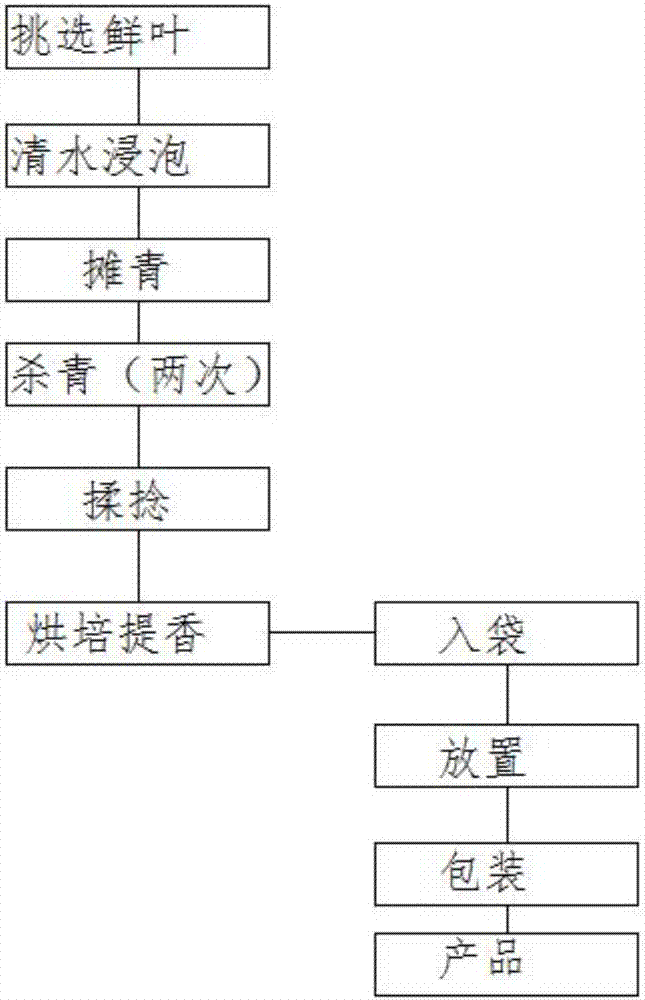Method for manufacturing lithocarpus polystachyus tribute tea by using lithocarpus polystachyus
A technology of wild golden wood and tribute tea, which is applied in the field of tea making, can solve the problems of destroying wild golden wood and bitterness of tea leaves
- Summary
- Abstract
- Description
- Claims
- Application Information
AI Technical Summary
Problems solved by technology
Method used
Image
Examples
specific Embodiment approach 1
[0024] The present invention will be further described below in conjunction with the accompanying drawings.
[0025] see as figure 1 As shown, the specific implementation method includes the following steps:
[0026] 1. Picking fresh young leaves of Wild Jinchai for selection;
[0027] 2. Soak the selected young leaves in mountain stream water for 30 minutes;
[0028] 3. Pick up the young leaves and spread the green leaves; when spreading the green leaves, turn them every 10 minutes, and pick out the miscellaneous tea leaves when turning them.
[0029] 4. For the first greening, start feeding fresh leaves when the temperature reaches 180°, stop feeding when the temperature is lower than 80°, and continue feeding when the temperature rises to 180°; the purpose is to destroy and oxidize the fresh leaves by high temperature Enzyme activity, inhibits the enzymatic oxidation of tea polyphenols in fresh leaves, and evaporates part of the water in fresh leaves; the greening machin...
specific Embodiment approach 2
[0036] This embodiment comprises the following steps:
[0037] 1. Picking fresh young leaves of Wild Jinchai for selection;
[0038] 2. Soak the selected young leaves in mountain stream water for 30 minutes;
[0039] 3. Pick up the young leaves and spread the green leaves; when spreading the green leaves, turn them every 20 minutes, and pick out the miscellaneous tea leaves when turning.
[0040] 4. For the first greening, start feeding fresh leaves when the temperature reaches 180°, stop feeding when the temperature is lower than 80°, and continue feeding when the temperature rises to 180°; the purpose is to destroy and oxidize the fresh leaves by high temperature Enzyme activity, inhibits the enzymatic oxidation of tea polyphenols in fresh leaves, and evaporates part of the water in fresh leaves; the greening machine adopts an automatic rolling type, and the fermentation drum is rotated forward and reversed for 5 minutes at a speed of 15 rpm, and left to stand Ferment for ...
specific Embodiment approach 3
[0047] This embodiment comprises the following steps:
[0048] 1. Picking fresh young leaves of Wild Jinchai for selection;
[0049] 2. Soak the selected young leaves in mountain stream water for 30 minutes;
[0050] 3. Pick up the young leaves and spread the green leaves; when spreading the green leaves, turn them every 30 minutes, and pick out the miscellaneous tea leaves when turning.
[0051] 4. For the first greening, start feeding fresh leaves when the temperature reaches 180°, stop feeding when the temperature is lower than 80°, and continue feeding when the temperature rises to 180°; the purpose is to destroy and oxidize the fresh leaves by high temperature Enzyme activity, inhibiting the enzymatic oxidation of tea polyphenols in fresh leaves, evaporating part of the water in fresh leaves; the greening machine adopts an automatic rolling type, and the fermentation drum is rotated forward and reversed for 7 minutes at a speed of 15 rpm, and left to stand Ferment for 6...
PUM
 Login to View More
Login to View More Abstract
Description
Claims
Application Information
 Login to View More
Login to View More - R&D
- Intellectual Property
- Life Sciences
- Materials
- Tech Scout
- Unparalleled Data Quality
- Higher Quality Content
- 60% Fewer Hallucinations
Browse by: Latest US Patents, China's latest patents, Technical Efficacy Thesaurus, Application Domain, Technology Topic, Popular Technical Reports.
© 2025 PatSnap. All rights reserved.Legal|Privacy policy|Modern Slavery Act Transparency Statement|Sitemap|About US| Contact US: help@patsnap.com

